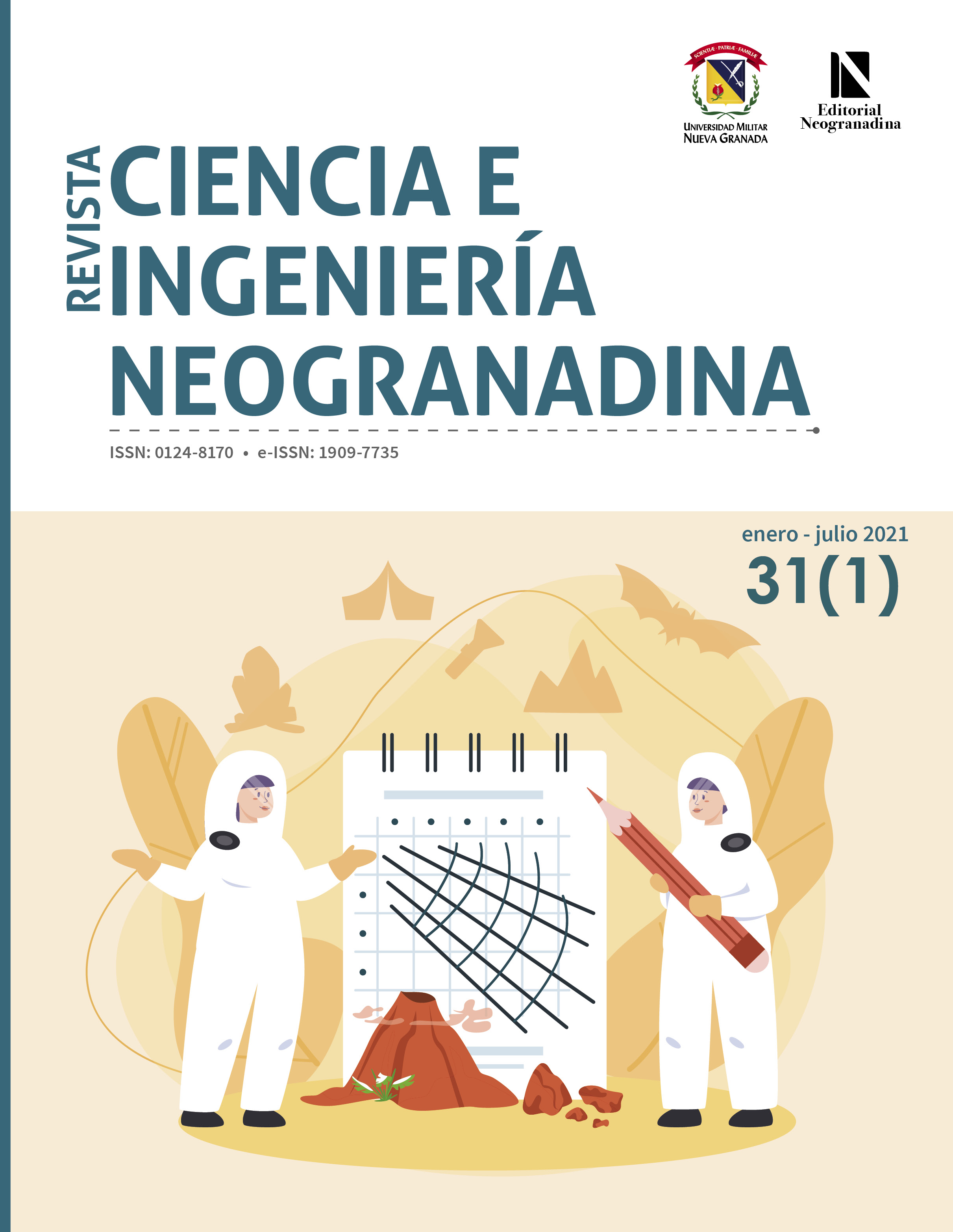Optimization of Water Transparency Monitoring through MOD09GA
A Case Study in Lake Guamués, San Juan de Pasto, Colombia
Abstract
Lake Guamués (LG) has been considered a Ramsar Wetland since 2000. Due to its importance, lenttic ecosystems such as LG require monitoring programs that exceed their spatial and temporal scope. This study shows that using surface reflectance products, generated by the Modis sensor, can be useful in verifying the spatial dynamics of the Secchi disk depth (ZSD), in the 2001-2020 period. To calibrate the model, an image matching the field work performed was used. The transparency data of the Secchi disk-measured water column was correlated with the image pixels captured in the band centered at 858.5 nm. To validate the model, the Leave Out One Cross Validation (LOOCV) method was used. Thus, it was determined that the quadratic model showed better results with an adjustment in its R2 = 0.74 and an error associated with observations less than 0.013 m. Spatial analysis revealed that LG has areas located at its banks, where the ZSD may be less than 0.5 m. Likewise, its ZSD average in the image taken on April 24 is 3.87 m. The temporal analysis of the lake indicates that between the 2006-2008 and 2017-2020 periods, greater variability has been reported for the observed points, with values of 3.3 and 2.8 m, respectively.
Downloads
Support agencies:
CESMAG University, UNADReferences
K. A. Moser, et al. “Mountain Lakes: Eyes on Global Environmental Change”, Global and Planetary Change, vol. 178, pp. 77-95, (2019). Doi: https://doi.org/10.1016/j.gloplacha.2019.04.001
Z. Zeng, D. Wang, W. Tan y J. Huang (2019). Extracting Aquaculture Ponds from Natural Water Surfaces around Inland Lakes on Medium Resolution Multispectral Images. International Journal of Applied Earth Observation and Geoinformation, vol. 80, pp. 13-25. Doi: https://doi.org/10.1016/j.jag.2019.03.019
T. Llorens-Marès, J. Catalán y E. Casamayor, “Taxonomy and Functional Interactions in Upper and Bottom Waters of an Oligotrophic High-mountain Deep Lake (Redon, Pyrenees) Unveiled by Microbial Metagenomics”, Science of the Total Envirnoment, vol. 707, pp. 1-9, 2020. Doi: https://doi.org/10.1016/j.scitotenv.2019.135929
H. Pirjo, J. Ramírez, L. Caputo e I. Gómez “Mapping of Spatial and Temporal Variation of Water Characteristics through Satellite Remote Sensing in Lake Panguipulli, Chile”, Science of the Total Environment, vol. 769, pp. 196-208, 2019. Doi: https://doi.org/10.1016/j.scitotenv.2019.04.367
O. Mare et al., “Impact of Anthropogenic Activities on Water Quality Parameters of Glacial Lakes from Rodnei Mountains, Romania”, Environmental Research, vol. 182, pp. 1-11, 2020. Doi: https://doi.org/10.1016/j.envres.2020.109136
C. Kuhn et al., “Performance of Landsat-8 and Sentinel-2 Surface Reflectance Products for River Remote Sensing Retrievals of Chlorophyll-a and Turbidity”, Remote Sensing of Environment, vol. 224, pp. 104-118, 2019. Doi: https://doi.org/10.1016/j.rse.2019.01.023
P. Majozi, M. Suhyb, S. Bernard, D. Harper y M. Ghirmai. “Remote Sensing of Euphotic Depth in Shallow Tropical Inland Waters of Lake Naivasha Using meris Data”, Remote Sensing of Environment, vol. 148, pp. 178-189, 2014. Doi: https://doi.org/10.1016/j.rse.2014.03.025
H. Froehlich, R. Gentry, M. Rust, D. Grimm y B. Halpern, “Public Perceptions of Aquaculture: Evaluating Spatiotemporal Patterns of Sentiment around the World. PLoS ONE, vol. 12, n.° 1, pp. 1-18, 2017. Doi: https://doi.org/10.1371/journal.pone.0169281
S. Palmer, T. Kutser, y P. Hunter, “Remote Sensing of Inland Waters: Challenges, Progress and Future Directions”, Remote Sensing of Environment, vol. 157, pp. 1-8, 2015. Doi: https://doi.org/10.1016/j.rse.2014.09.021
K. Bosse, et al., “Spatial-Temporal Variability of in situ Cyanobacteria Vertical Structure in Western Lake Erie: Implications for Remote Sensing Observations”, Journal of Great Lakes Research, vol. 45, n.° 3, pp. 480-489, 2019. Doi: https://doi.org/10.1016/j.jglr.2019.02.003
G. Zheng et al. “Sustained Growth of High Mountain Lakes in the Headwaters of the Syr Darya River, Central Asia”, Global and Planetary Change, vol. 176, pp. 84-99, 2019. Doi: https://doi.org/10.1016/j.gloplacha.2019.03.004
M. Xu et al., “A Spectral Space Partition Guided Ensemble Method for Retrieving Chlorophyll-A Concentration in Inland Waters from Sentinel-2a Satellite Imagery”, Journal of Great Lakes Research, vol. 45, n.° 3, pp. 454-465, 2019. Doi: https://doi.org/10.1016/j.jglr.2018.09.002
J. Cannizzaro et al., “Remote Detection of Cyanobacteria Blooms in an Optically Shallow Subtropical Lagoonal Estuary Using modis Data”, Remote Sensing of Environment, vol. 231, pp. 1-18, 2019. Doi: https://doi.org/10.1016/j.rse.2019.111227
L. Feng, X. Hou y Y. Zheng, “Monitoring and Understanding the Water Transparency Changes of Fifty Large Lakes on the Yangtze Plain Based on Long-term modis Observations”, Remote Sensing of Environment, vol. 221, pp. 675-686, 2019. Doi: https://doi.org/10.1016/j.rse.2018.12.007
Q. Zhou, et al., “Seasonal and Spatial Distributions of Euphotic Zone and Long-Term Variations in Water Transparency in a Clear Oligotrophic Lake Fuxian, China”, Journal of Environmental Sciences, vol. 72, pp. 185-197, 2018. Doi: https://doi.org/10.1016/j.jes.2018.01.005
C. Giardino, M. Pepe, P. Brivio, P. Ghezzi y E. Zilioli, “Detecting Chlorophyll, Secchi Disk Depth and Surface Temperature in a Sub-Alpine Lake Using Landsat Imagery”, Science of the Total Environment, vol. 268, n.° 1-3, pp. 19-29, 2001. Doi: https://doi.org/10.1016/S0048-9697(00)00692-6
V. Bohn et al., “Development of an Empirical Model for Chlorophyll-a and Secchi Disk Depth Estimation for a Pampean Shallow Lake (Argentina), The Egyptian Journal of Remote Sensing and Space Science, vol. 21, n.° 2, pp. 183-191, 2018. Doi: https://doi.org/10.1016/j.ejrs.2017.04.005
Z. Lee, S Shang, L. Qi, J. Yan y G. Lin, “A semi-analytical scheme to estimate Secchi-disk depth from Landsat-8 measurements”, Remote Sensing of Environment, vol. 177, pp. 101-106, 2016. Doi: https://doi.org/10.1016/j.rse.2016.02.033
S. Peckham y T. Lillesand, “Detection of Spatial and Temporal Trends in Wisconsin Lake Water Clarity Using Landsat-derived Estimates of Secchi Depth”, Lake and Reservoir Management, vol. 22 n.° 4, pp. 331-341, 2006. Doi: https://doi.org/10.1080/07438140609354367
M. Pereira-Sandoval et al., “Calibration and Validation of Algorithms for the Estimation of Chlorophyll-a Concentration and Secchi Depth in Inland Waters with Sentinel-2, Limnetica, vol. 38, n.° 1, pp. 471-487. Doi: https://doi.org/10.23818/limn.38.27
F. Gao, Y. Wang y X. Hu, “Evaluation of the Suitability of Landsat, meris, and modis for Identifying Spatial Distribution Patterns of Total Suspended Matter from a Self-organizing Map (som) Perspective. CATENA, vol. 172, pp. 699-710, 2019. Doi: https://doi.org/10.1016/j.catena.2018.09.031
C. Huang, Y., Zhang, T. Huanga, H. Yanga, Y. Li y Z. Zhang, “Long-term Variation of Phytoplankton Biomass and Physiology in Taihu Lake as Observed Via modis Satellite. Water Research, vol. 153, pp. 187-199. Doi: https://doi.org/10.1016/j.watres.2019.01.017
R. Eraso, M. Galo, E. Alcântara, M. Shimabukuro y A. Carmo, “Locally Tuned Model to Map the Chlorophyll-a and the Trophic State in Porto Primavera Reservoir Using modis/Terra Images”, Modeling Earth Systems and Environment, pp. 1-9, 2018. https://doi.org/10.1007/s40808-018-0415-3
S. Wang et al., “Trophic State Assessment of Global Inland Waters Using a modis-derived Forel-Ule Index”, Remote Sensing of Environment, vol. 217, pp. 444-460, 2018. Doi: https://doi.org/10.1016/j.rse.2018.08.026
Z. Cao, et al., “Using viirs/npp and modis/Aqua data to provide a continuous record of suspended particulate matter in a highly turbid inland lake. International Journal of Applied Earth Observation and Geoinformation, vol. 64, pp. 256-265, 2018. Doi: https://doi.org/10.1016/j.jag.2017.09.012
K. Shi, Y. Zhang, B. Qin y B. Zhou, “Remote Sensing of Cyanobacterial Blooms in Inland Waters: Present Knowledge and Future Challenges”; Science Bulletin, vol. 64, n.° 20, pp. 1540-1556, 2019. Doi: https://doi.org/10.1016/j.scib.2019.07.002
I. McCullough, C. Loftin y S. Sader, “High-frequency Remote Monitoring of Large Lakes with modis 500 m Imagery,” Journal of Remote Sensing of Environment, vol. 124, pp. 234-241, 2012. Doi: https://doi.org/10.1016/j.rse.2012.05.018
I. Knight y M. Voth, “Application of modis Imagery for Intra-annual Water Clarity Assessment of Minnesota Lakes”, Journal of Remote Sensing of Environment, vol. 4. n.° 7, pp. 2181-2198, 2012. Doi: https://doi.org/10.3390/rs4072181
G. Wu, J. de Leeuw, A. Skidmore, H. Prins y Y. Liu, “Comparison of Modis and Landsat TM5 images for mapping tempo–spatial dynamics of Secchi disk depths in Poyang Lake National Nature Reserve, China”, International Journal of Remote Sensing, vol. 29, n.° 8, pp. 2183-2198, 2008. Doi: https://doi.org/10.1080/01431160701422254
Z. Chen, C. Hu y F. Muller-Karger, “Monitoring Turbit y in Tampa Bay Using. Journal Remote Sensing of Environment”, vol. 109, n.° 2, pp. 207-220, 2007. Doi: https://doi.org/10.1016/j.rse.2006.12.019
K. Koponen, et al., “Analysis on the Feasibility y of Multi-source Remote Sensing Observations for chl-a Monitoring in Finnish Lakes”, Science of the Total Environment, vol. 268, n.° 1-3, pp. 287-291, 2001. Doi: https://doi.org/10.1016/s0048-9697(00)00689-6
C. Petus, G. Chust, F. Gohin, D. Doxaran, J. Froidefond, y Y. Sagarminaga, “Estimating Turbidity and Total Suspended Matter in the Adour River Plume (South Bay of Biscay) Using modis 250-m Imagery. Continental Shelf Research, vol. 30, n.° 5, pp. 379-389, 2010. Doi: https://doi.org/10.1016/j.csr.2009.12.007
L. Zhu, S. Wang, Y. Zhou y F. Yan, “Estimation of Suspended Sediment Concentration Changes in Taihu Lake Based on Mult i-temporal modis Image Data. In: Symposium Geoscience and Remote Sensing Symposium (igarss), pp. 3023-3026, 2006. Doi: https://doi.org/10.1109/IGARSS.2006.776
S. Chen, L. Han, C. Xiuzhi, L. Dan, S Lin y Y. Li., “Estimating Wide Range Total Suspended Solids Concentrations from modis 250-m Imageries: An Improved Method. ISPRS Journal of Photogrammetry and Remote Sensing, vol. 99, pp. 58-69, 2015. Doi: https://doi.org/10.1016/j.isprsjprs.2014.10.006
D. Jiang, B. Matsushita, F. Setiawan y A. Vundo, “An Improved Algorithm for Estimating the Secchi Disk Depth from Remote Sensing Data Based on the New Underwater Visibility Theory. ISPRS Journal of Photogrammetry and Remote Sensing, vol. 152, pp. 13-23. Doi: https://doi.org/10.1016/j.isprsjprs.2019.04.002
V. Bohn, F. Carmona, R. Rivas, L. Lagomarsino, N. Diovisalvi y H. Zagarese, “Development of an Empirical Model for Chlorophyll-a and Secchi Disk Depth Estimation for a Pampean Shallow Lake (Argentina)”, The Egyptian Journal of Remote Sensing and Space Sciences, vol. 21, n.° 2, pp. 183-191, 2018. Doi: https://doi.org/10.1016/j.ejrs.2017.04.005
A. Kulshreshtha y P. Shanmugam, “Estimation of Secchi Transparency in Turbid Coastal Waters. Aquatic Procedia, vol. 4, pp. 1114-1118, 2015. Doi: https://doi.org/10.1016/j.aqpro.2015.02.141
E. González-Legarda, M. Imuez, G. Duque, E. Burbano y C. Guerrero, “Efecto de la producción acuícola sobre las variables de calidad del agua del lago Guamuez. Revista Investigación Pecuaria, vol. 5, n.° 2, pp. 33-43. Doi: https://doi.org/10.22267/revip.1851.4
J. Duque, M. Hermelin y G. Toro, “The Guamuez (La Cocha) Lake”, En Landscapes and Landforms of Colombia. World Geomorphological Landscapes. M. Hermelim (Ed.). Springer. 2016, pp. 203-212. Doi: https://doi.org/10.1007/978-3-319-11800-0_17
E. Saeid, K. Bakioglu, J. Kellogg, A. Leier, J. Martínez y E. Guerrero, “Garzón Massif basement tectonics: Structural control on evolution of petroleum systems in upper Magdalena and Putumayo basins, Colombia. Marine and Petroleum Geology, vol. 88, pp. 381-401, 2017. Doi: https://doi.org/10.1016/j.marpetgeo.2017.08.035
E. Burbano, R. Aparicio, G. Duquey M. Imuez, “Impactos de la acuicultura en los nutrientes del agua y macroinvertebrados bentónicos del lago Guamuez”, MVZ Córdoba, vol. 23, n.° S, pp. 7035-7047, 2018. Doi: https://doi.org/10.21897/rmvz.1429
M. López y S. Madroñero, “Estado trófico de un lago tropical de alta montaña: caso laguna de La Cocha”, Ciencia e Ingeniería Neogranadina, vol. 25, n.° 2, pp. 21-42, 2015. Doi: https://doi.org/10.18359/rcin.1430
K. Shi, Y. Zhang, G. Zhu, B. Qin y D. Pan, “Deteriorating Water Clarity in Shallow Waters: Evidence from Long Term modis and In-Situ Observations”, International Journal of Applied Earth Observation and Geoinformation, vol. 68, pp. 287-297, 2018. Doi: https://doi.org/10.1016/j.jag.2017.12.015
S. Chen, L. Han, X. Chen, D. Li, L. Sun y Y. Li, “Estimating Wide Range Total Suspended Solids Concentrations from Modis 250-M Imageries: An Improved Method. ISPRS Journal of Photogrammetry and Remote Sensing, vol. 99, pp. 58-69, 2015. https://doi.org/10.1016/j.isprsjprs.2014.10.006
A. Digliotti, K. Ruddick, B. Nechad, D. Doxaran y E. Knaeps, “A single Algorithm to Retrieve Turbidity from Remotely-sensed Data in All Coastal and Estuarine Waters. Remote Sensing of Environment, vol. 156, pp. 157-168, 2015. Doi: https://doi.org/10.1016/j.rse.2014.09.020
R. Moncayo, “Mapeo de la Dinámica regional de la transparencia en aguas continentales usando productos de reflectancia mod09ga”, vol. 13 n.° 2, Entramado, pp. 270-276, 2017. Doi: https://doi.org/10.18041/entramado.2017v13n2.26233
S. Hafeez, M. et al., “Comparison of Machine Learning Algorithms for Retrieval of Water Quality Indicators in Case-Ii Waters: A Case Study of Hong Kong. mdpi Remote Sensing”, vol. 11, n.° 6, pp. 1-26, 2018. Doi: https://doi.org/10.3390/rs11060617
L. Arias, Z. Duan, R. Sepúlveda, S. Martínez y M. Disse, “Monitoring Water Quality of Valle de Bravo Reservoir, Mexico, Using Entire Lifespan of meris Data and Machine Learning Approaches”, MDPI Remote Sensing, vol. 12, n.° 10, pp. 1-26, 2020. Doi: https://doi.org/10.3390/rs12101586
K. Alikas y S. Kraratzer, “Improved retrieval of Secchi Depth for Optically-Complex Waters Using Remote Sensing Data”, Ecological Indicators, vol. 77, pp. 218-227, 2017. Doi: https://doi.org/10.1016/j.ecolind.2017.02.007
C. Neil, E. Spyrakos, P. Hunter y A. Tyler, “A Global Approach for Chlorophyll-a Retrieval Across Optically Complex Inland Waters Based on Optical Water Types. Remote Sensing of Environment, vol. 229, pp. 159-178, 2019. Doi: https://doi.org/10.1016/j.rse.2019.04.027
V. Sagan, et al. (2020), “Monitoring Inland Water Quality Using Remote Sensing: Potential and Limitations of Spectral Indices, Bio-optical Simulations, Machine Learning, and Cloud Computing”, Earth-Science Reviews, vol. 205, pp. 1-31. Doi: https://doi.org/10.1016/j.earscirev.2020.103187
B. Demir, F. Bovolo y L. Bruzzone, Classification of Time Series of Multispectral Images With Limited Training Data. IEEE, vol. 2, n.° 8, pp. 3219-3233, 2013. Doi: https://doi.org/10.1109/TIP.2013.2259838
W. Javed, B. McDonnel y N. Elmqvist, “Graphical Perception of Multiple Time Series”, IEEE Transactions on Visualization and Computer Graphics, vol. 16, n.° 6, pp. 927-934, 2010. Doi: https://doi.org/10.1109/TVCG.2010.162
T. Le, T. Dang y T. Luong, “Visualizing Access Logs of a Scientific Digital Library Effectively as Multiple Time Series Using Modified Horizon Graphs”, International Conference on Advanced Computing and Applications, pp. 85-91, 2019. Doi: https://doi.org/10.1109/ACOMP.2019.00020
W. Aigner, H. Schumann y C. Tominski. Visualization of Time-Oriented Data. Londres: Springer, 2011.
J. Heer, N. Kong y M. Agrawala, “Sizing the Horizon: The Effects of Chart Sizeand Layering on the Graphical Perception of Time Series Visualizations”, Conference Proceedings of the sigchi Conference on Human Factors in Computing Systems, pp. 1303-1312, 2009. Doi: https://doi.org/10.1145/1518701.1518897
S. Few, “Time on the Horizon”, Visual Business Intelligence Newsletter, pp. 1-7, 2008.
T. Saito, H. Nakamura, M. Yamamoto, H. Saito, Y. Hosida y T. Kaseda, “Two-Tone Pseudo Coloring: Compact Visualization for One-Dimensional” IEEE Symposium on Information Visualization, pp. 173-180, 2005.
A. Jabbari, R. Blanch y S. Dupuy-Chessa, “Composite Visual Mapping for Time Series Visualization”, IEEE Pacific Visualization Symposium, pp. 116-124, 2018.
M. Butt y M. Nazeer, “Landsat etm+ Secchi Disc Transparency (sdt) Retrievals for Rawal Lake, Pakistan”, Journal Advances in Space Research, vol. 56, n.° 7, pp. 1428-1440, 2015. Doi: https://doi.org/10.1016/j.asr.2015.06.041












